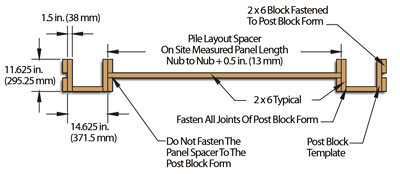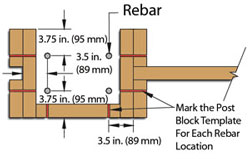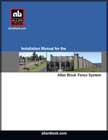Technical Newsletter
Issue 23
Project Information
Name: University of Arkansas
Fayetteville, Arkansas
Product:AB Fence System
Size:8700 ft ² (808 m ² )
Architect:Polk Stanley Wilcox
Local Engineer:Kenneth Jones & Associates
General Contractor:Flintco, LLC
Allan Block Manufacturer:
Midwest Block and Brick
Springdale, AR
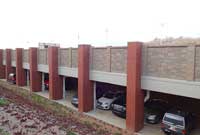
The field was constructed on top of the level of the garage structure

AB Fence Wind Load
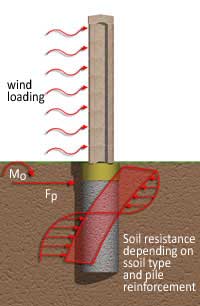
AB Fence Post Section
Elevated Field Created Design Challenges
To say that football is a way of life in the south is an understatement. Consider the University of Arkansas Razorbacks - They have had a football team since 1894 and football is an important part of the university and their culture. In proof of their dedication and as part of their facility master plan for Razorback Athletics, the university built a new football operational facility to support their team.
When the University of Arkansas recently upgraded their football practice facilities, the architect selected the Allan Block Fence system for the fencing around the practice fields. The AB Fence system was selected for the project because it was a cost effective solution that was aesthetically pleasing as well. The AB Fence system also proved to be flexible enough to handle some of the more challenging design requirements.
In order to construct the new operational building, it was decided to move the outdoor practice fields to the south side of the Walker Family Training Center. The architects of the project considered the available space and decided a multi-use facility would best serve the team and the functionality of the surrounding buildings, by placing the new practice field above a new parking facility. This presented a number of design challenges, but functioned perfectly for the team while providing much needed parking.
Typically, AB Fence posts are built on pile footings. These standard footings were not feasible in the areas of the elevated garage deck. The engineer solved this by designing the perimeter beam to carry not only the loads from the elevated field, but also the overturning moment force from the cantilevered AB Fence system. This alternate fence footing design solved the challenge of building AB Fence for a non-standard application. The end result is a beautiful fence that provides privacy, security, and safety to the Arkansas Razorbacks football program.
Overview of the AB Fence® System
AB Fence is a mortarless concrete block fencing system that uses maintenance free interlocking blocks to create an attractive and effective solution for sound abatement, security, privacy and more. The fence system transfers wind loads horizontally to posts through interlocking fence panel units and integral bond beams to create post and panel sections. Ultimately, the loads are transferred from the posts to the supporting footings. However, the actual footing requirements are minimal compared to traditional cast-in-place fence designs with the entire load of the AB Fence being resisted by footings only at the posts. Only a small leveling pad is required beneath the fence panel since the panels are able to move and flex with any soil movement.
The stabilizing foundation to the entire AB Fence system is a reinforced concrete footing. Footings can be designed in many different styles but they all are intended to resist the lateral and vertical applied forces. The typical AB Fence footing is a 2 ft (0.6 m) diameter concrete pile footing utilizing simple vertical steel reinforcement directly under the post. The site specific parameters such as soil strength and wind loading will determine the design diameter, depth of each pile hole and the size or amount of rebar. By increasing the pile footings diameter, depth or reinforcement schedule, the capacity of the footing can be increased.
Occasionally, there are situations where a traditional pile footing cannot be accommodated. The cost of the footing and its impact on the structure’s design will need to be evaluated when determining which footing to use. The Allan Block Fence system will work with any type of foundation system that is properly designed to adequately handle the overturning moments required for the project. Optional footings that have been used in the past with the AB Fence include:
- Spread Footings – The spread footings have been used in areas were deep drilling or excavation is not permitted. This shallow foundation transfers the loads to the earth near the surface, which results in a little larger footprint for the footing itself.
- Cantilever Footings – As you saw in the above story, the post footings needed to be constructed over the parking ramp. Cantilever footings have also been used when constructing the AB Fence on existing retaining walls. This keeps the additional overturning forces from the fence from impacting the retaining wall.
The AB Fence system is a versatile product that can be built for a number of configurations. It is a system that provides flexibility to your design challenges and site constraints. No matter what type of footing your project requires, an Allan Block Fence application can provide the solution you are looking for at a cost effective price.
AB Fence Construction – Jigs
Locating the posts on top of the piles correctly on a fence project is crucial. The AB Fence System is a modular system so minimal cutting is required to build any project. Before determining pile locations a few simple on-site tools can make the job go much smoother. Using the following construction jigs will help your project go together quickly saving time and money.
Pile Layout Jig
It is recommended that before digging any post footings be sure to determine the exact post spacing by field measuring the blocks. To determine the length, on a flat surface, line up the number of panel blocks used for each panel with a post block on each end. Be sure to have the 0.25 in (6.5 mm) gap between the end of the panel nub and the bottom of the post pocket. The center to center of post dimension is your post spacing.
The pile layout jig is used in conjunction with the post block templates shown here. Simply cut a 2x6 to length. The length is the field measured panel block plus 0.50 in. (13 mm) to account for the 0.25 in (6.5 mm) gap mentioned above.
Create a pile layout jig for each different length panel. Using them will allow you to accurately mark the center of your footings prior to digging. Once the piles are dug, the layout jig can also be used to accurately make the post location on the footing and the vertical rebar positions.
This is a summerized excerpt from the AB Fence Installation Manual. Requesta copy from your local AB representative or check it out online here for additional jigs, helpful tips and complete installation details.
Plan Your Fence Layout
Allan Block has tools available to makes it easy to draw your fence panels. The AutoCAD Fence Macro allows you to configure your panels to fit any project requirements. It helps lay out multiple panels, detailed panel drawings, panel sections, and post sections. Download the Allan Block Fence Macro for AutoCAD to quickly lay out standard pattern and Ashlar pattern fence designs.





